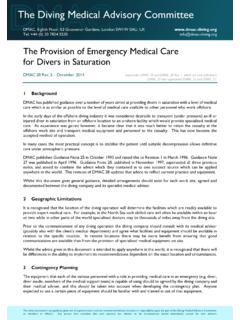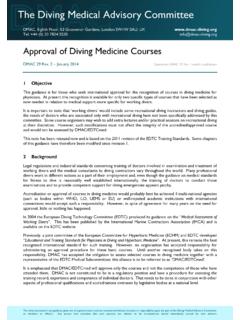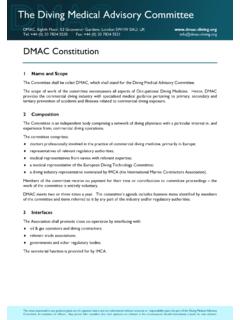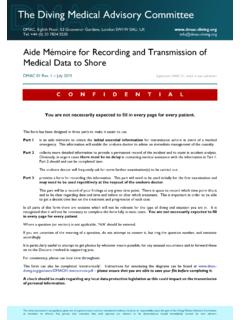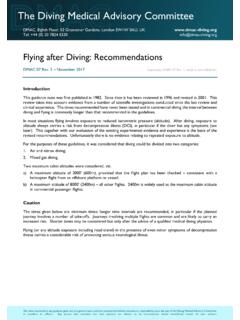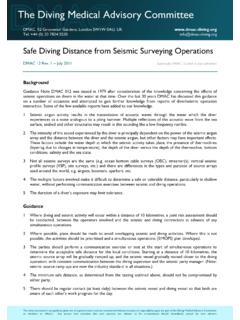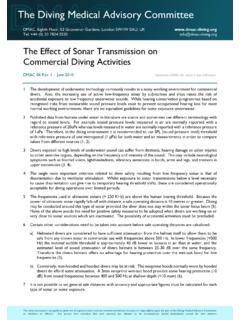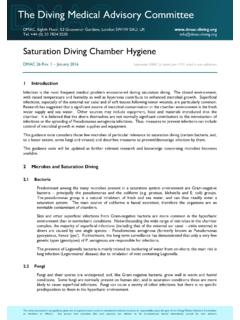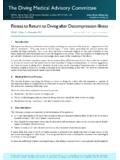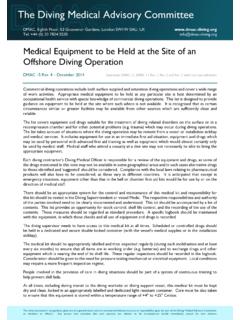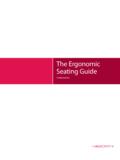Transcription of The Diving Medical Advisory Committee
1 The Diving Medical Advisory Committee DMAC, Eighth Floor, 52 Grosvenor Gardens, London SW1W 0AU, UK Tel: +44 (0) 20 7824 5520 The views expressed in any guidance given are of a general nature and are volunteered without recourse or responsibility upon the part of the Diving Medical Advisory Committee , its members or officers. Any person who considers that such opinions are relevant to his circumstances should immediately consult his own advisers. Provision of First Aid and the Training of Divers, Supervisors and Members of Dive Teams in First Aid DMAC 11 Rev. 1 November 2001 Supersedes DMAC 11 dated February 1983, which is now withdrawn 1 Introduction Commercial Diving exposes divers to a variety of hazards specific to their work in addition to many hazards shared with other workers.
2 While these hazards can be well controlled by adherence to good working practices, the potential for serious injury remains. As a result there is a requirement for contingency planning for Medical emergencies caused both by accident and illness occurring during Diving operations. This involves access to suitably qualified Medical support (DMAC 017), adequate Medical /first aid equipment available on site (DMAC 015 Rev. 1) and appropriately trained immediate first aid assistance as described in this guidance note. Additional requirements for saturation Diving are described in DMAC 028. The legislative requirements for occupational first aid provision differ between countries. Many countries will have additional legislative requirements for work involving Diving , which will set minimum standards.
3 The following guidance establishes the basic principles necessary to provide an adequate standard of care dependant on the risk assessment. 2 Risk Assessment In planning first aid support for a Diving operation, the risk assessment should consider: Type of Diving technique: Surface orientated (scuba or surface supplied) Bell bounce or saturation Breathing gas Emergency Medical services: Location, communications and response time Call out procedure Transportation Qualifications and experience of personnel Medical support: Secondary Medical care (hospital) available Availability of Medical supplies Hyperbaric chamber facilities 3 Levels of First Aid Training Title Training Aim Initial Diver Training also called Diving First Aid To assess and establish the needs of a Diving casualty including first aid at work, knowledge of Diving physiology and Diving related illness, administration of oxygen and assisting in the treatment of Diving illness.
4 First Aid at Work To deal safely and effectively with injuries or illness at work. Oxygen administration To safely administer pure oxygen or oxygen enriched breathing gas mixtures to a Diving casualty. Diver Medic To administer advanced first aid and life support skills in the management of Diving casualties including treatment while at pressure and during saturation Diving operations. Page 2 November 2001 DMAC 11 Rev. 1 4 All Divers All divers should be trained in the first aid management of those common illnesses and injuries to which they may be exposed. This training should include the use of common items of first aid equipment including oxygen administration systems. In most situations this will form a part of basic diver training. 5 Supervisors Diving supervisors and life support supervisors should have received training in Diving first aid as part of their early training.
5 As a result they should be familiar with the first aid equipment provided at the dive site and with the required response to Medical emergencies. They should be familiar with and competent in the prevention, recognition and management of Diving related illness and particularly with the contractors specific procedures for the treatment of decompression illness. In most circumstances responsibility for the provision of first aid will be delegated to a designated first aider in which case it is not a requirement for the supervisor to hold a valid first aid qualification. 6 Dive Team Personnel Additional training or familiarisation may be required in the use of equipment or techniques used for a particular project. 7 Recompression Facilities In Diving operations where a recompression chamber is on site, sufficient divers should have received additional first aid training to ensure that one trained diver can accompany the injured diver during treatment inside the chamber.
6 Their training should be at diver medic level. Consideration should be given to provision of another outside the chamber, particularly to act as a communication link to remote Medical advice. Alternatively this requirement can be met if there is an alternative medically trained person available to provide support at the chamber rig medic or nurse. 8 Saturation Diving During saturation Diving , the number of diver medic trained personnel required should take account of the following: One trained diver medic must remain outside the chamber at all times for purposes of communications and provision of equipment. This role can be met by a rig medic or nurse or by a member of the dive team with medic training. A minimum of two trained diver medics should be at pressure in the chamber system.
7 A lower level of provision could result in the situation where the only trained diver medic is the casualty. Where a saturation system is operating with chambers at different depths, all divers must retain rapid access to a trained diver medic. 9 Validity of Training Qualifications and Refresher Training First aid knowledge and skills decline with time after training, particularly where practical use of knowledge and skills is infrequent. This is particularly relevant to decompression illness where an individual first aider s exposure to the illness is likely to be minimal. Personnel assigned specific first aid or diver medic duties must hold valid in date qualifications. First aid at work and diver medic qualifications should be valid for no more than three years1. Where refresher training is carried out less than three months before the expiry date of the current certificate, the start date of the new certificate may begin from the expiry date of the current certificate.
8 1 From 1 July 2013 all certificates issued by IMCA diver medic recognised training establishments are valid for two years instead of three years (Ref. IMCA D 05/13). DMAC 11 Rev. 1 November 2001 Page 3 APPENDIX Minimum Content and Length of Courses (including Assessment) All training should be provided by accredited diver or first aid training organisations. Course provision should be subject to assessment by a third party organisation recognised by an appropriate national body. First Aid at Work (minimum 24 hours) Communication and allocation of responsibility in emergency Resuscitation Management of unconscious patient Treating shock Treating and controlling bleeding Treating injuries to bones, muscles and joints Treating eye injuries and conducting eyewash Treating minor injuries First aid management of poisoning, gas and fume exposure Moving injured people Recognising illness Treating burns ands scalds Personal hygiene Cross infection in treatment of wounds Use of first aid kit material Simple record keeping Oxygen Administration (minimum 4 hours)
9 Knowledge and recognition of illness which benefit from administration of pure oxygen or oxygen enriched breathing mixtures Understanding of the benefits of providing pure oxygen or oxygen enriched breathing mixtures Understanding of the potential hazards of working with pure oxygen or oxygen enriched breathing mixtures Demonstration of the safe administration of pure oxygen or oxygen enriched breathing mixtures from an administration kit to a breathing and non-breathing casualty The safe assembly/disassembly of an oxygen administration kit Initial Diver Training (minimum 40 hours) First aid at work Barotrauma of middle and inner ear, paranasal sinuses, the lung (pneumothorax, pneumomediatinum, subcutaneous emphysema and arterial gas embolism) Near drowning Carbon dioxide retention Oxygen toxicity Vomiting underwater Underwater blast injury Oxygen administration Decompression illness pathophysiology, clinical features including examination and management Nitrogen narcosis Carbon monoxide poisoning Anoxia/hypoxia Hypothermia Additional for mixed gas diver training High pressure nervous syndrome and compression arthalgia Page 4 November 2001 DMAC 11 Rev.
10 1 Diver Medic Training Initial Training (minimum 60 hours) Structure and function of heart circulation and blood, lungs, ears, sinuses, central and peripheral nervous system, musculoskeletal system special sense organs Taking a Medical history The methods of casualty transfer including transfer within the hyperbaric environment, use of stretchers, helicopter transport etc. The transfer of Medical information and record keeping Management of Diving illness including barotrauma, decompression illness, near drowning, infections, gas toxicity, nitrogen narcosis, oxygen toxicity, blast injury, high pressure nervous syndrome (HPNS), hypo and hyperthermia Maintenance of Medical equipment at the dive site Management of casualty in hyperbaric environment Management of emergencies in the Diving bell including recovery, resuscitation in the bell, lost bell procedures and hyperbaric evacuation The hazards of drugs, infusion equipment and pleural drains under pressure Measurement of vital signs, pulse blood pressure, respiration rate and temperature Resuscitation Use of clean and sterile techniques Administration of oxygen Assist in airway management, endotracheal intubation or insertion of laryngeal mask Setting up intravenous fluid infusions Assist in the insertion pleural drains Insertion of urinary catheter Suturing and parenteral administration of drugs
